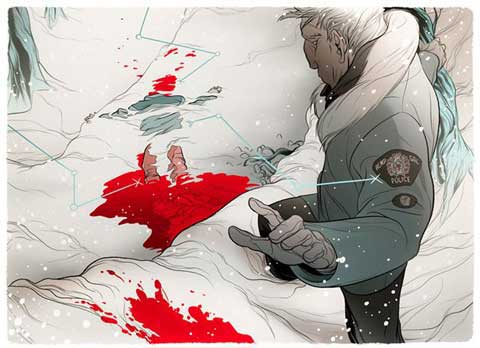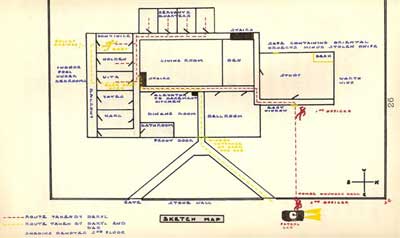Slade's Blog
THE STORY BEHIND THE STORIES
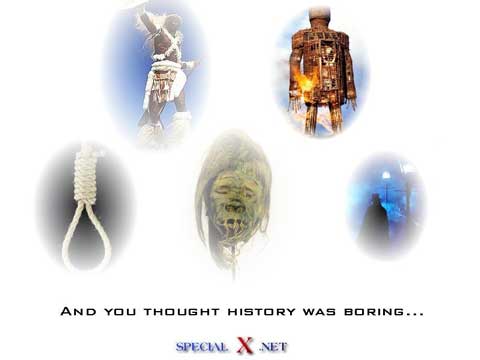
The past creates the future by passing through the present. The motives for murder teach every criminal lawyer that; so that's the dominant theme of all Slade's novels. Because each thriller finds its plot in historical fact, Slade seems to have a lucky knack for glimpsing what's to come.
Consider the improbable odds of foreseeing all of this:
HEADHUNTER (1984): Slade had an idea for a whodunit twist, and planned to use the Yorkshire Ripper as a model for his plot. On the day he sat down to structure his story, the Clifford Olson case broke in 1981.
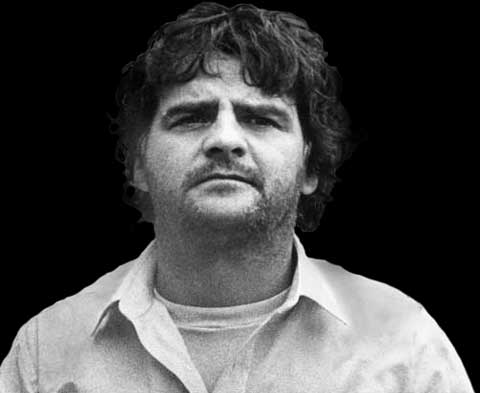
Clifford Olson
Between November 1980 and July 1981, Olson kidnapped and killed nine youths and two children in Greater Vancouver. Eight were girls, three were boys, and most were raped.
The police in general - and the RCMP in particular - were harshly criticized for their handling of the case. In Greater Vancouver, each city and municipality either contracts with the Mounted Police to set up a detachment of the federal force or recruits its own police department. In this manhunt, the scattered Mounties and independent forces failed to share and pursue information they had on Olson, which allowed him to slip through the cracks of turf wars and pecking orders. To build a court case after his arrest, B.C. authorities paid $10,000 for each body Olson helped recover.
In all, Olson's wife received $100,000 for his cooperation.
Slade was called to the bar in 1972. The law firm he joined had three offices. When those offices were combined as one on Maple Tree Square in Gastown, the pioneer core of Vancouver, the effect was evident. With all the lawyers under one roof and discussing their thoughts in the coffee room, every case reaped the benefit of combining all those legal minds.

The Gastown law firm (top floor)
By 1981, Slade had defended several murder cases jeopardized by lack of police integration. To plug that hole (the Olson lesson) in HEADHUNTER, he created a fictional RCMP integrated homicide investigation team called Special X. The Mounties had Special I (the wiretappers), Special O (the trackers), and Special E (the gang squad). X - let's face it - is the coolest letter in the alphabet. Gathered under one roof, Special X would liaise with all Greater Vancouver police forces. If a link, no matter how small, connected two murders, the cops investigating both cases would join Special X.
In Slade's fictitious alternate world, Special X occupies the Tudor building at 33rd and Heather.
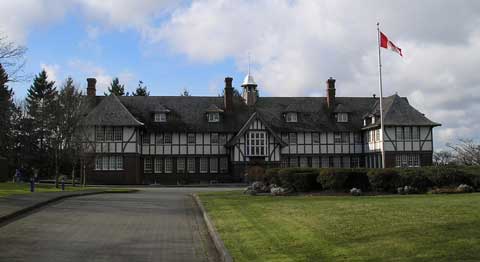
Special X HQ (photo by James Kennelly)
Chief Superintendent Robert DeClercq's office with the Strategy Wall is the sunlit front corner square on the upper floor, far right. The Squad Room for all Special X psycho-hunters - both Mounties and independent cops - is the main floor. The Cyber Cellar beneath that is home to psych profilers, ViCLAS (the Violent Crime Linkage Analysis System), and geographic profilers.
Because Vancouver Police Detective Al Flood catches one of the Headhunter murders, he joins Special X.

Slade's invitation to the Mounties' Red Serge Ball

Slade's invitation to be Guest Speaker at one of several RCMP Red Serge Dinners
Right from the start of Slade's writing career, the Mounties (and the Vancouver Police) helped him in every way possible to research his thrillers. Techs in the crime lab - DNA, firearms, etc. - worked out the forensics. Street patrols offered Slade ride-alongs and details from real-life chases. Take-downs were stategized by the emergency response team. Explosives were explained by the bomb squad. Slade flew in RCMP planes and cruised the West Coast in a police boat. Female members who breached the male bastion in 1974 were frank about the backlash.
As each new psycho-hunting technique came along, Slade - through DeClercq - worked it into Special X. Psychological profiling features in RIPPER (1994), ViCLAS in PRIMAL SCREAM (SHRINK) (1998), and geographic profiling in BURNT BONES (1999).
The 1990s saw Slade attend the Red Serge Ball, and be guest speaker at several regimental dinners. As READER'S DIGEST put it (March 2001, page 20): "The Slade books have developed a strong following among police officers because of their strict adherence to proper police procedure."
All that culminated in 1998 when Slade was invited to address the Police Leadership '98 Conference. High-ranking officers from the Mounties, the FBI, Scotland Yard, various U.S. sheriffs departments, and police forces from as far away as Australia met in Vancouver. Slade was luncheon speaker.
His topic? "The Creation and Structure of Special X."
Days later, the conference coordinator wrote Slade a letter: "Your address was enjoyable and entertaining and very well received by the Conference delegates."
However...
Throughout the 1990s, Slade had picked up on a disconnect between the Mounties' leadership and the upcoming ranks. The old guard seemed to view him as a defense lawyer living out an "If I ran the Mounties" fantasy for their entertainment, while the new blood undoubtedly saw in Special X an integrated psycho-hunting unit that was missing from the force.
Several times at Red Serge events, Slade was questioned along the line of: "If the brass ever get around to creating Special X, will you allow us to use that name?"
The staff sergeant heading ViCLAS reported in THE OUTLOOK (December 6, 2001): "I asked Slade if I could photocopy the chapter in PRIMAL SCREAM specific to ViCLAS because we were having horrendous marketing problems with the police community at large. We distributed the chapter to our ViCLAS centers across Canada, and that has proven one of our most successful marketing tools. Before PRIMAL SCREAM made the rounds, ViCLAS had a compliance rate of just 9 percent. Today that number is 91 percent."
As one frustrated cybercop put it, "Now all we need is C/Supt. Robert DeClercq."
Between 1978 and 2001 - that's from the time of Clifford Olson on - 65 women went missing from the skid road area of Vancouver. Not until September 2001 - and under intense pressure from the media and the missing women's relatives - did the Mounties and the Vancouver Police form a joint task force.

In February 2002, Greater Vancouver awoke to news that Robert "Willie" Pickton, a Port Coquitlam pig farmer, had been arrested in the Missing Women Case. Pickton confessed to 49 murders. He was charged with the murders of 26 women whose DNA was found at the farm. One of those women was a long-time client of Slade's.

Robert Pickton
As with Olson, the police were harshly criticized for their handling of the case. How had a serial killer - perhaps the most prolific in North American history - gone undetected for decades? The victims were from Vancouver, the jurisdiction of the VPD. The farm was in Port Coquitlam, policed by the Mounties. Because there was no integrated homicide investigation team, the scattered Mounties and independent city police had failed to share and pursue information they had on Pickton, which allowed him to slip through the cracks of turf wars and pecking orders.
Finally, in 2003, the RCMP formed IHIT (pronounced I-HIT), the Integrated Homicide Investigation Team.

GHOUL (1987): Of all the Slade novels, GHOUL is the most horrific. The rock musician Alice Cooper said of it: "Reading Michael Slade is like taking an advanced course in Psycho Horror. HEADHUNTER stunned me. GHOUL convulsed me. This book is terrifying. I couldn't put it down."
When Slade meets a fan of a particular novel, he usually asks, "How did you discover the book?" Chances are with GHOUL, the answer will be: "I hadn't heard of you. But if your book scared Alice Cooper, that's good enough for me."
In the early 1980s, Slade read a short piece in the paper about a European killer who disposed of a body by feeding it to pigs. In the chapter titled "Revenge is a Dish Best Served Cold" (William Morrow edition of GHOUL, pages 298 to 302), the Ghoul disposes of a victim that way.
In the chapter "Raw Meat" (Morrow, pages 118 to 125), GHOUL's psycho grinds a victim up in a meat-packing plant, then sells the flesh as hot dogs.
The inspiration for that was two killers in post-World War I Germany.
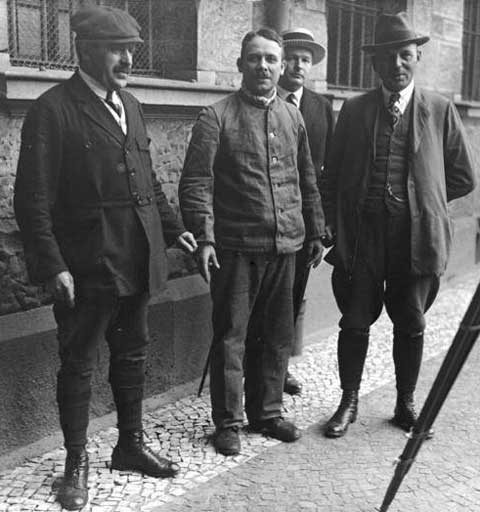
Fritz Haarmann, hatless, with police detectives, 1924 (Deutsches Bundesarchiv)
Between 1918 and 1924, Fritz Haarmann - dubbed "the Butcher of Hanover" and "the Vampire of Hanover" - killed at least 24 boys and young men. He would lure them home from Hanover's railway station, bite their throats during his sexual attack, and later sell meat from their bodies as black market "pork."
Haarmann confessed to killing between 50 and 70 victims. He was beheaded by guillotine in 1925. His head is preserved at Gottingen medical school.

Georg Karl Grossmann
Between 1918 and 1921, Georg Karl Grossmann killed as many as 50 women. Like Haarmann, he met his victims at the Berlin train station and lured them home. The next day, he sold their meat as frankfurters on the same platform. When arrested at his apartment, he was mincing his latest victim into hot dogs.
Before Grossmann could be executed, he hanged himself in his cell.
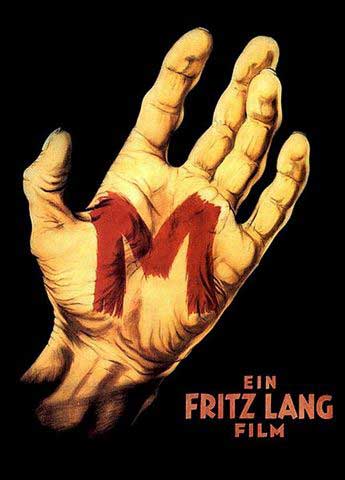
In his classic 1931 film M, director Fritz Lang based the killer on Haarmann and Grossmann (see his 1963 interview).
In M, Peter Lorre plays the serial killer:

When GHOUL was published in 1987, there were less than 10 Missing Women. In Slade's thriller, Special X Mounties are hunting for a serial killer who feeds his victims to pigs or distributes their meat as "pork."
When Pickton was arrested in 2002 - 15 years and at least 26 victims after GHOUL - the Mounties found that he had fed Missing Women to pigs, and they issued a warning to all who had obtained "pork" from his farm.
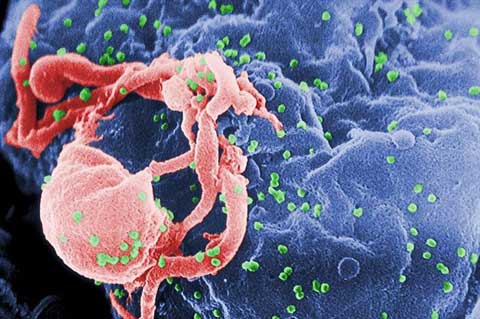
The AIDS virus
Do you think the AIDS virus - seen here by electron microscope - looks like the thing that latches onto John Hurt's face in Ridley Scott's ALIEN (Slade's favorite horror film)?
In the mid-1980s, Slade read an article in ROLLING STONE magazine about a viral plague attacking predominantly gay men. Since gay men - he'd been told by nurses - were the most conscientious Red Cross blood donors, he knew that virus - now called HIV - would hijack the blood bank.
For hemophiliacs, the blood bank is their lifeline. So Slade conceived GHOUL's Vampire Killer as driven to drain pre-pubescent girls to ensure he has a "clean" supply of blood. That psycho is based on three real-life cases.
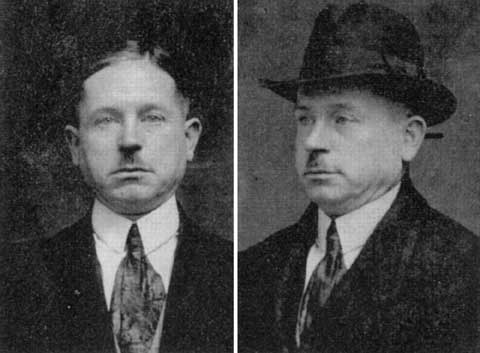
Mugshot of Peter Kurten, "the Vampire of Dusseldorf" (1931)
Between 1913 and 1929, Peter Kurten killed at least 9 victims of both sexes with knife, hammer, or scissors, and attempted to kill 7 more. In all, he confessed to 79 offenses. Reports that he was drinking their blood led to his German press name.
Kurten's mental illness was hematomania. His bloodlust was literal: blood fetishism or sexual attraction to blood. Since blood was integral to his orgasm, the number of wounds depended on how long that took.
In 1931, Kurten was guillotined. His mummified head's in the RIPLEY'S BELIEVE IT OR NOT! museum.

John George Haigh, "the Vampire Killer" (1949)
John George Haigh is better known as London's "Acid Bath Murderer." Between 1944 and 1949, he killed at least 6 victims and dissolved them in drums of sulphuric acid. Haigh put the number at 9. Murder was proved because one woman's gallstones didn't dissolve.
Haigh confessed to drinking his victims' blood, most likely to plead insanity. Despite a warning about prejudicing the trial, the DAILY MIRROR ran the headline "Vampire - A Man Held." Its editor got 3 months in jail for contempt, and the paper was fined 10,000 pounds.
Haigh was hanged in 1949. He willed his clothes to Madame Tussaud's Chamber of Horrors.
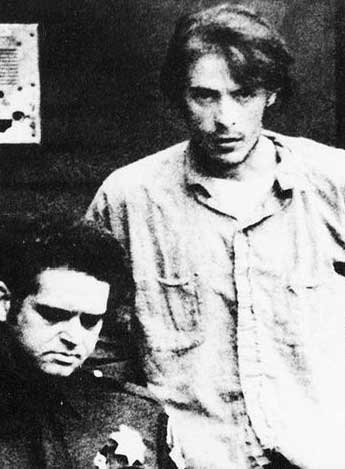
Richard Chase, "the Dracula Killer" and "the Vampire of Sacramento" (1978)
In 1977 and 1978, Richard Chase killed 6 Californians and drank their blood. He suffered from what is best described as Renfield Syndrome, named for the insect-eating assistant in Bram Stoker's DRACULA. Chase thought his blood was turning to powder, so he had to replenish it. He drank blood cocktails prepared in a blender.
Sentenced to die in the gas chamber, Chase killed himself in 1980 by ODing on hoarded prescription drugs.
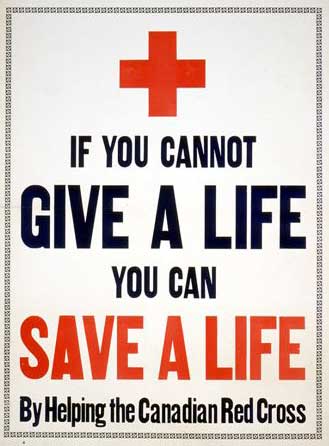
In the decade after GHOUL was published, its premise became fact. The Red Cross tainted blood scandal is Canada's worst-ever public health disaster. About 2,000 hemophiliacs and transfusion recipients contracted HIV/AIDS. A judicial inquiry found the Red Cross had performed inadequate screening of at-risk groups.
For its mismanagement of the blood bank, the Red Cross was stripped of its oversight role in 1998. In 2001, the Supreme Court of Canada found the Red Cross negligent.
So, the Vampire Killer's fear in GHOUL proved real.

CUTTHROAT (1992): Of all the Slade novels, CUTTHROAT is the most unconventional. Vancouver's Chinatown was a block away from Slade's Gastown law office and the criminal courts. CUTTHROAT's plot grew out of the wildlife yang medicines sold in Chinatown's traditional medicine stores.
When Slade was a boy, he tried to eat a piece of raw bacon. His mother warned him about the danger of trichinosis, a parasitic worm that can attack the central nervous system. When Slade was in China researching CUTTHROAT, he snapped this photo of a civet cat in the wildlife market of Guangzhou (Canton).
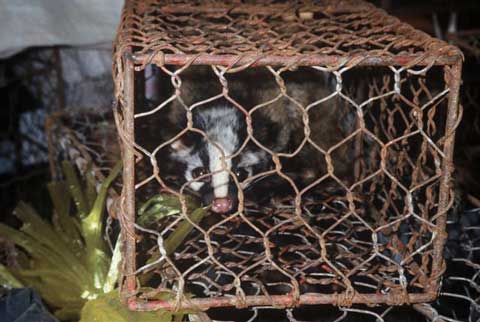
Despite its name, that's not a cat, but a nocturnal mammal related to a mongoose. In Chinese medicine, its musky anal scent gland is used in a potion to induce abortion. In "dragon, tiger, and phoenix soup," its meat fights arthritis, stimulates blood flow, and peps up libido.
CUTTHROAT centers on a deadly virus that jumps species through traditional Chinese medicine.
In 2002 - a decade after CUTTHROAT was published - eating civet cat meat in southern China allowed its coronavirus to jump species to human beings and cause 2003's SARS epidemic, a respiratory illness that (according to WHO, the World Health Organization) killed almost 775 people and sickened more than 8,000 around the world.

Spongiform holes in brain tissue
In CUTTHROAT, eating Alma yang causes kuru disease. Known as "laughing sickness," kuru is an incurable, degenerative, spongiform brain ailment transmitted as a prion by cannibalizing flesh that's genetically human-related.
Who isn't intrigued by cryptozoology? The possible survival of humanoid species like the Sasquatch (Bigfoot), the Yeti, and the Alma?
When CUTTHROAT was published, science maintained that 40,000 years ago, the earth was shared by the last two hominid species to live side-by-side: the Neanderthals and us. It now appears there may have been four.
In 2003, Flores Man - just three feet tall - was discovered on Flores Island in Indonesia. Because of his diminished height, Homo floresiensis was dubbed the "hobbit." Humans reached that area about 24,000 years ago. Hobbits - on the current evidence- survived until 12,000 years ago.
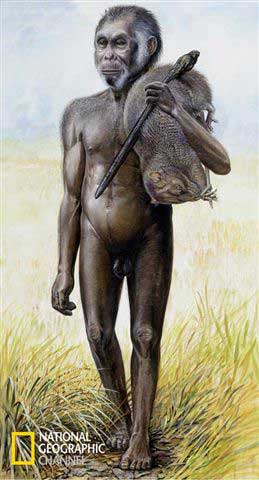
Flores Hobbit in NATIONAL GEOGRAPHIC
In March 2010, the journal NATURE reported that DNA tests on finger bones found in the Denisova Cave in the Altai Mountains of Siberia, China, and Mongolia proved they came from another hominid that lived 40,000 years ago. The "Denisova hominin" likely overlapped with both us and Neanderthals in that area.
The same realm as CUTTHROAT's cryptic Almas.

RIPPER (1994): In Slade's fourth thriller, a Leopold-and-Loeb-like killing team of Nietzschean "supermen" recreate Jack the Ripper's occult ritual in the Pacific Northwest.
A puzzling aspect of the Ripper's 1888 London murders is that his first 4 victims - if plotted on an East End map - form an inverting cross.
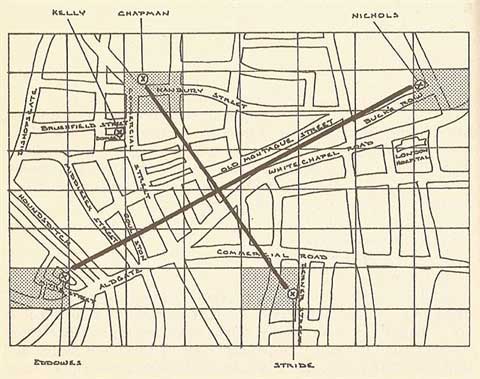
To assess the statistical probability of four scattered victims forming that cross, Slade consulted a university mathematician. The professor told him to overlay a map of the Ripper's East End murder sites with a 64-square chessboard grid. The odds of Polly Nichols being killed in her square are 1 in 64; of Annie Chapman in her square, 1 in 63; of Liz Stride in her square, 1 in 62; and of Catherine Eddowes in her square, 1 in 61. Therefore, the overall odds of the Ripper's cross forming randomly - given the state of geographic profiling in 1888 - are 1 x 1 x 1 x 1 over 64 x 63 x 62 x 61 = 1 in 15,249,024.
After RIPPER was published, Slade received a letter dated November 20, 1994:
"I am writing to tell you how much I enjoyed reading RIPPER. You might be interested to know that analysis of crime site locations has now become an investigative strategy in certain types of serial violent crime cases. Geographic profiling is used to determine the most likely area for offender residence, and has been applied in investigations of serial murder, serial rape, and serial arson. In addition to the more subjective interpretation of the criminal's mental map, specialized computer software is used to calculate a three-dimensional probability surface, the height of which represents the likelihood that the offender resides in a given location. Various investigative stategies can then be developed based on such a geographic prioritization. It was most intriguing to read, in a work of fiction, about the use of spatial analysis in a serial murder investigation."
The letter - signed "Kim Rossmo" - was mailed from Simon Fraser University.
To learn more, Slade phoned the SFU campus. He was told that Rossmo was a Vancouver Police beat cop working on his Ph.D in Criminology.
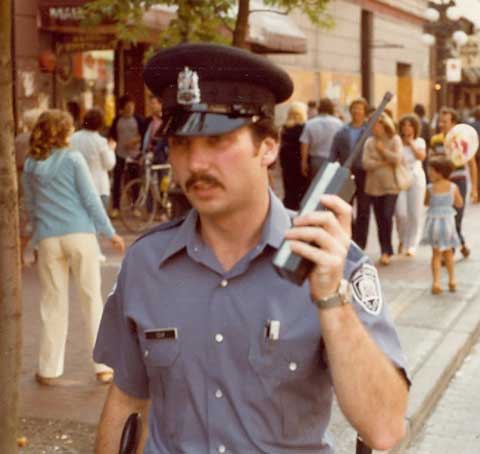
Constable Kim Rossmo walking his beat in Gastown
The following year, Rossmo and his creation - Geographic Profiling - would revolutionize how psycho-hunters stalk serial predators.

ZOMBIE (EVIL EYE) (1996): The crime writer who influenced Slade the most was Ed McBain (1926 - 2005). McBain's first 87th Precinct novel was COP HATER (1956).
On March 29, 1974, John Miller and Vincent Cockriell were drinking at a party. Miller's brother had recently died during a police chase, so they set out to kill a cop for revenge.
In Cloverdale, British Columbia, the courthouse and the police station were side by side. Cockriell hurled a beer bottle through the courthouse window to attract attention. Constable Roger Pierlet was on patrol alone. He stopped their car, radioed in the license number, then approached the driver.
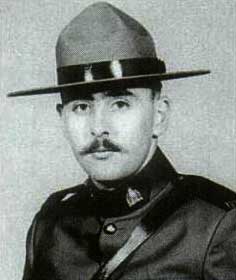
Miller sat in the driver's seat with a cocked rifle resting on his arms. When Pierlet asked Miller to get out of the car, Cockriell pulled the trigger from the passenger's seat and shot him in the heart.
A wild car chase ensued before they were arrested. Convicted of murder, both men were sentenced to hang.
Slade argued Cockriell's appeal in the Supreme Court of Canada. By coincidence, on the same day, Parliament voted to abolish the death penalty. Cockriell's sentence to hang was commuted to life imprisonment.
HANGMAN (2000) - Slade's 8th novel - grew out of that experience. By tradition, a lawyer "sees his client out." Slade could have witnessed a hanging.
In ZOMBIE - his 5th novel - Slade conceived a cop hater who mass murders. Canada's the only country known first and foremost for its police. The Mounties' Red Serge uniform is second only to Coca-Cola's logo in worldwide recognition. ZOMBIE's psycho fixates on that icon.
Nine years after ZOMBIE was published, a real-life cop hater committed mass murder.
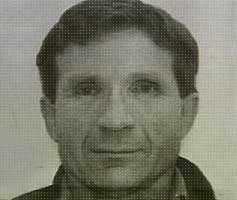
James Roszko was a psychopathic cop hater. In trouble with the law since his teens, the 46-year-old gun-lover was known to booby-trap his Mayerthorpe, Alberta farm. Violent, paranoid, and a psycho who blamed the police for all his problems, Roszko was a walking time bomb.
On March 2, 2005, the Mounties arrived to back up bailiffs repossessing Roszko's truck. The psycho fled. When police found an auto chop shop and a marijuana grow op in his Quonset hut, they staked out the farm.
Ranting and vowing to "get even" with the cops, Roszko armed himself with a .308 assault rifle and other firearms, then crossed a snowy field to sneak back onto his land.
The next morning, he ambushed and killed four Mounties, then shot himself.
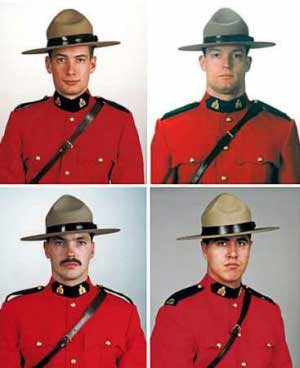
The Mayerthorpe murders were the RCMP's greatest loss of life in a single day in more than 100 years.
The tragedy illustrates how "The Mounties always get their man." To secure manslaughter convictions against two accomplices who helped Roszko, 200 Mounties worked the manhunt at a cost of $2 million.

PRIMAL SCREAM (SHRINK) (1998): Sometimes you're in the right place at the right time. And so it was with Slade.
The novels of Thomas Harris - particularly THE SILENCE OF THE LAMBS (1988) - introduced the reading public to psychological profiling from crime scene analysis. In other words, the crime scene left behind by a killer provides forensic clues to his/her mental state.
That, however, is just Step 1 in psycho-hunting.
Step 2 requires gathering all the crimes of a killer together. For that, the FBI created VICAP and the Mounties created ViCLAS, the Violent Crime Linkage Analysis System. Both computer programs work like this. Detectives investigating a murder fill out a booklet of questions designed to capture the killer's "signature": those aspects unique to him or her. In Canada, the answers are fed into ViCLAS, and the computer searches for links to other cases. It's the tool Mounties use to expose serial killers.
PRIMAL SCREAM - Slade's 6th novel - features ViCLAS. You'll find a real-life ViCLAS form on page 88 of the Viking edition:

A year after receiving the RIPPER letter above, Slade heard that Constable Kim Rossmo had been catapulted up through four ranks of the Vancouver Police Department - corporal, sergeant, staff sergeant, and inspector - to Detective Inspector in charge of the VPD's new Geographic Profiling unit.
Rossmo's doctoral dissertation - GEOGRAPHIC PROFILING: TARGET PATTERNS OF SERIAL MURDERERS (1995) - had the FBI at Quantico, Cambridge University, and a host of others headhunting him.
By accumulating 225 known serial killers and devising a math formula based on spatial probability that tracked each killer to an anchor point - his home or work - within, on average, 5% of his overall killing ground, Rossmo had created Step 3 in psycho-hunting.
Armed with the Step 1 psych profile, cops could then search the whittled-down area for suspects who fit the psycho's signature.

Detective Inspector Kim Rossmo (photo by The Vancouver Sun)
Rossmo is a mathematician who thrives on the challenge of policing. Before his promotion to detective inspector, he spent 8 of his 15 years service on the streets of Vancouver's crime-infested skid road, 2 years on a special task force dealing with prostitution and drugs, 2 years in organized crime intelligence, and 1 year in crime prevention.
Only by giving up sleep could he also attend university. He'd walk his beat until 2 a.m., work on his thesis (first his Masters, then his Ph.D) in the university lab until dawn, then drive to court and read academic journals until he was called to testify against those he'd busted. Then he'd grab some sleep. And that went on for years.
He wasn't just a thinker; he did the dangerous stuff too.
DeClercq's kind of cop.
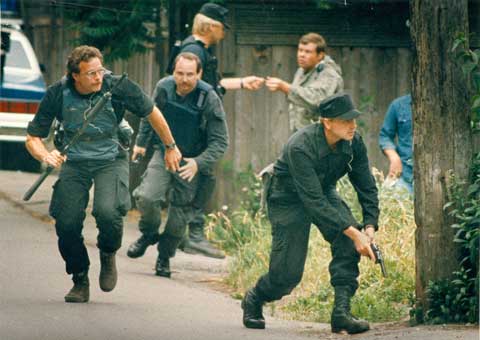
Rossmo caught during an emergency response (photo by The Province)
Slade and Rossmo first met in the ViCLAS office at RCMP Headquarters in 1995. The cybercop invited him to VPD Headquarters to see how Geographic Profiling worked.
Having passed through security on the day agreed, Slade rode the elevator up to Rossmo's floor. On stepping out, he asked directions to the cybercop's office from two detectives talking in the hall. Though Rossmo's accomplishments were all over the media, they grinned at each other and told Slade they'd never heard of him.
Slade found the office on his own and thought, "God help us if those two ever hunt a serial killer. They can't even find an office on their own floor."
Had he but known...
Like most human activities, crime has a geographic logic. Each time a serial predator meets, attacks, kills, or dumps a victim, he leaves behind a point on a map.

Rossmo's crime site map
The postman cuts across your lawn; he doesn't use the walk. To buy a jug of milk, you go to the nearest store, not one 10 miles away. That's because you're governed by "the least-effort principle," and your "activity space" is shaped by a mental map tied in predictable ways to your anchor point: your home.
The same with serial killers.
Fear of arrest creates a buffer zone of predictable dimensions before a predator starts to hunt. The farther he goes from home, the less his hunting ground overlaps with his "awareness space," so the less likely he is to hunt for victims and chance getting caught.
Predictable behavior can be mathematically quantified. By applying the laws of probability to each point on a computer screen, Rossmo's creation computes the likelihood of that point being the killer's home, and generates a "jeopardy surface" like the one below.
The hotter the color, the more likely that's where the serial killer lives.

Rossmo's geoprofile of a serial killer's mental map
Slade - as you can imagine - was itching to be the first to work that into a novel. Geographic Profiling appears in the "Where Not Why" chapter of PRIMAL SCREAM (Viking edition, pages 241 to 245).
By then - 1998 - Slade was already at work on his 7th thriller, in which Detective Inspector Kim Rossmo, appearing as himself, would use his cyber creativity to expose a gruesome, psychopathic, local serial killer.
Little did anyone realize that Rossmo would soon, in fact, do that.

BURNT BONES (1999): Between the publication of GHOUL in 1987 and PRIMAL SCREAM in 1998, at least 30 more women went missing from Vancouver's skid road.
No crime reports meant no crime linkage. No crime scenes meant no psychological profiling. No points on a map meant no geographic profiling.
A stealth killer is a tough nut to crack. Forensic tools become impotent. A stealth killer isn't out for notoriety. His core strategy is to kill in such a way that nobody knows he's on the hunt. A stealth killer sees himself as the Invisible Man.
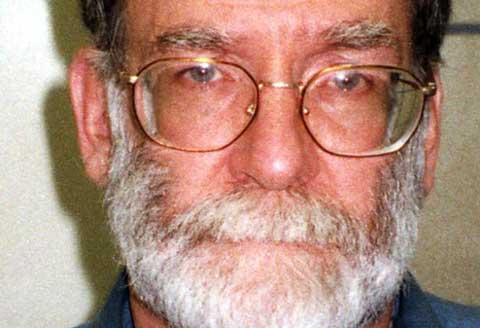
Study this face. That's Dr. Harold Shipman, probably Britain's most prolific serial killer. In 2000, he was convicted of 15 murders. Later, the Shipman Inquiry found that he was most likely responsible for about 250 deaths.
Shipman killed his patients with heroin overdoses. Then he certified their deaths were from natural causes, and forged records to show their poor health.
Only in the last year of his two-decade murder spree - from 1978 to 1998 - was Shipman detected. The stealth killer hanged himself in 2004.
To analyze Vancouver's Missing Women mystery, Rossmo used a new method involving mapping spatial-temporal clusters. The cybercop adapted models designed by epidemiologists to track outbreaks of virulent disease.
Historically, Vancouver had different prostitute strolls based on the income level and sexual orientation of potential clients. The location of various strolls had shifted over time. None of that, however, prevented Rossmo from computerizing historical patterns. From the number of missing-person reports that each stroll had generated in the past, as well as the "survival rate" for missing women - how long before they were usually found - he derived a math formula that told him what to expect with the Missing Women.
Instead, the graph on his computer screen spiked abnormally. The cybercop suspected he was looking at a stealth-predator pattern. The present-day numbers were far too high. Too many women had disappeared in too short a time period from too small an area.
In the autumn of 1998, based on that analysis, Rossmo suggested the VPD should issue a public warning and develop a two-stage investigative plan. Not only was he ignored by senior officers, but the Vancouver Police Department publicly stated that it did not believe a serial killer was loose.
Why?
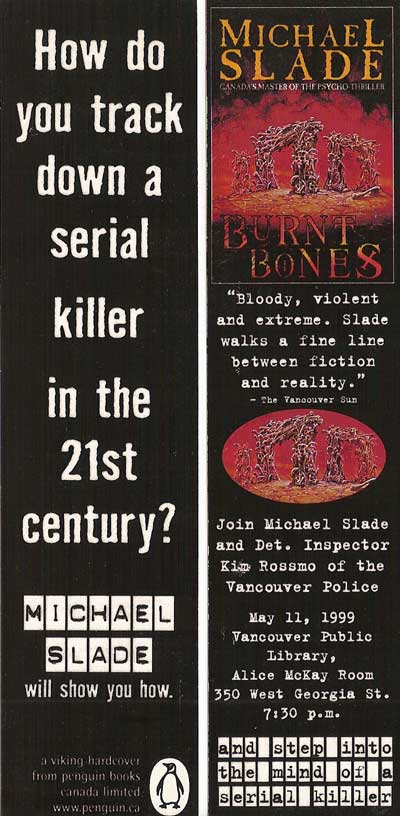
Rossmo's "lost office" at VPD Headquarters was but the tip of the iceberg. Just as Slade had noticed a puzzling disconnect between the Mounties' leadership and the upcoming ranks, he picked up on a distasteful schism in the upper ranks of the Vancouver Police Department.
Rossmo's unprecedented promotion rankled those clinging to an outdated traditional cop culture. Having worked their way up through the school of hard knocks or internal politics, they resented him doing it by a 21st-century creation they did not understand. To show their contempt, homicide cops refused to use Rossmo's cyber expertise.
They shut him out.
That would-be bully tactic reached the level of the absurd when Rossmo tried to enter the VPD's inner sanctum: the officers' mess. They made him the only inspector restricted to "associate membership."
By 1999, the media were commenting on the schism. A June 19 headline in THE VANCOUVER SUN: "More accepted by a mystery writer than some Vancouver police colleagues, serial-killer profiler Kim Rossmo has a lot to prove." Later, READER'S DIGEST: "'I know it works, this invention of yours,' Slade's hero, Chief Supt. Robert DeClercq, tells Rossmo in BURNT BONES. The difficulty is in convincing real cops."
In 2000, the knives came out. For no reason except he was too good at his job, senior cops told Rossmo they were shutting down his unit, stripping him of rank, and busting him back to constable.
The cybercop said, "No thanks," and looked for other work. He was snapped up by the Police Foundation in Washington, D.C., and you probably saw him on international TV with Chief Charles Moose, who called Rossmo in to profile the Beltway Sniper case (John Muhammad and Lee Malvo).
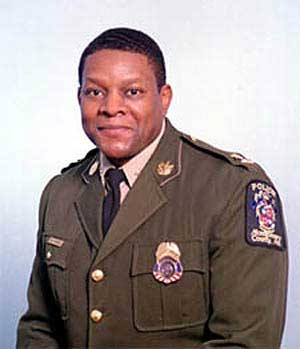
Chief Charles Moose, Montgomery County Police
In 2002, the VPD woke up to the fact that a stealth killer - Pickton - had murdered as many as 50 Missing Women that the force was duty-bound to protect, while senior officers were preoccupied with all but giving the bum's rush out of town to the cop who had cyber-detected what was going on.
Between the time that Rossmo's warning was ignored and Pickton's arrest four years later, 13 more women went missing. The DNA of 11 of them was found at the pig farm.
SWASTIKA (2005) ("Stealth Killer" chapter, Penguin edition, pages 44 to 57) fictionalizes what the police could have done with Rossmo's expertise.
From 2003 on, Dr. Kim Rossmo has been a research professor at Texas State University's Department of Criminal Justice, where he occupies the Endowed Chair in Criminology. Police forces around the world have called him in on over 200 serial cases involving about 3,000 crimes. The U.S. government has invested millions of dollars in his proven methodology to hunt active terrorist cells, predict the location of wartime improvised explosive devices (IEDs), and rapidly pinpoint the release location of bioterrorist contagions.
In August 2010, the Vancouver Police Department released a scathing internal report on what went wrong in the Eastside Missing Women case. Vancouver police "should have recognized earlier that there was a serial killer at work and responded appropriately." The VPD investigation, the report says, was hobbled by the "failure" of management "to recognize what it was faced with," while geographic profiler Kim Rossmo's "uncannily accurate" warnings that a serial killer could be at work went unheeded.
In September 2010, B.C.'s attorney general ordered a public inquiry into the flawed police investigation that allowed Pickton to continue hunting sex workers.
To frame the relevant questions - in Slade's opinion - the public inquiry's lawyers need look no farther than here (CRC Press, 2009):
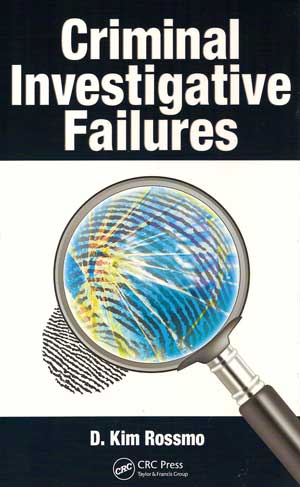

DEATH'S DOOR (2001): In 1999, while DEATH'S DOOR was being written, a newspaper photographer snapped several shots of the members of "Special X" standing in front of the Tudor building at 33rd and Heather.
That "integrated homicide investigation team" - whose input is in the chapters "X Is For Extreme" (Viking edition, pages 127 to 140), "Hit List" (pages 226 to 228), "What? Why? Who?" (pages 235 to 245), "Hunting the Hunters" (pages 254 to 263), "Cyber Sleuths" (pages 286 to 290), "Bingo" (pages 300 to 302), and "Mental Map" (pages 315 to 319) - consisted of Michael Slade, the Mounted Police staff sergeants in charge of ViCLAS and psychological profiling, the Vancouver Police detective in charge of geographic profiling, and a British forensic detective.
They had just given a wide-ranging joint interview on how a consolidated and integrated psycho-hunting squad would work. Special X was the model.
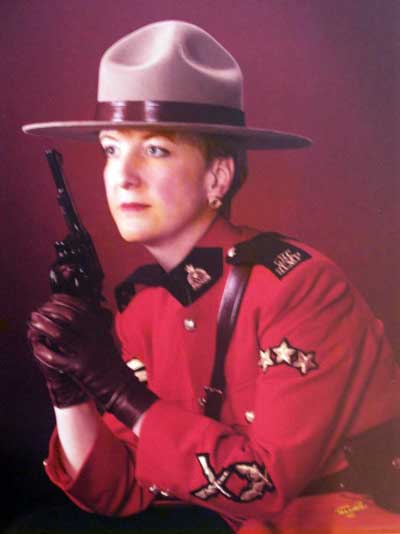
Markswoman (note the cuff badges) Staff Sergeant Christine Wozney, head of ViCLAS
In 1961, when Slade was 14, he devoured this book: 700 pages on history's 300 most baffling killers and how the police used the latest forensic techniques to hunt them.
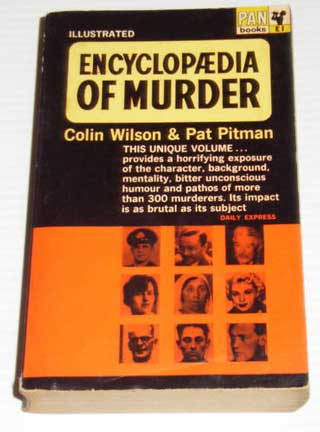
In 1967, when Slade was 20, he gained all-but-impossible access to Scotland Yard's Black Museum, the macabre display of the actual forensic clues that cracked the Yard's toughest cases (see RIPPER). Slade's father's cousin's husband's father was high-up in the Yard.

This is Orson Welles, speaking from London.
(Sound of Big Ben chimes)
The Black Museum... a repository of death. Here in the grim stone structure on the Thames which houses Scotland Yard is a warehouse of homicide, where everyday objects... a woman's shoe, a tiny white box, a quilted robe... all are touched by murder.
By 1981, when Slade sat down to create Special X, he had defended and prosecuted well over 1,000 cases investigated by the Mounties and the Vancouver Police. So he knew their weaknesses, and had capitalized on them in court.
To structure Special X, Slade was influenced by two books.

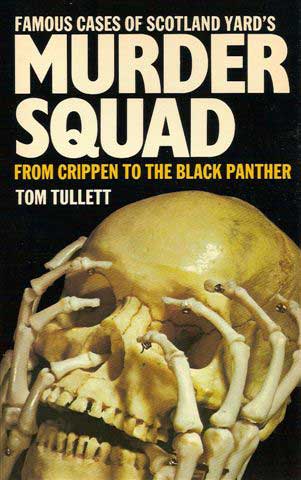
Scotland Yard's Murder Squad was formed in 1907 to assist British police forces outside London and provide forensic expertise in the field of murder. The Met detectives worked in consultation with the local police, and ensured they got copies of all reports. Thus the origin of "Call in the Yard."
The glaring lesson every cop should have learned from the Olson case was that with its patchwork of isolated and independent police forces, Greater Vancouver required an integrated Murder Squad. For Special X, Slade adapted the Yard's creation to Olson weaknesses.
When he met Rossmo at ViCLAS in 1995, the cybercop's first question was, "What are you working on now?"
Slade replied, "A thriller about a hunter who stalks naked prey through the northern woods."
"Like Robert Hansen?" Rossmo asked.

Robert Hansen was an Alaska hunter who killed at least 17 women between 1980 and 1983. He would pick up a victim for sex, take her to his plane, and fly her out to his remote cabin. After rape and torture, he'd release her naked into the woods, then hunt her down with a high-powered rifle.
How many cops know that?
When Slade read Rossmo's dissertation, he was more impressed. Published in 2000 by CRC Press, GEOGRAPHIC PROFILING lists hundreds of serial killers (page 245 on) that Rossmo can discuss in detail.

Is it any wonder that POPULAR SCIENCE (April 2003) wrote of him in "The Hound of the Data Points" - "Geographic profiling pioneer Kim Rossmo has been likened to Sherlock Holmes; his Watson in the hunt for serial killers is a digital sidekick"? Or that Paramount Pictures hired him to geoprofile the ZODIAC (2009) killer? Or that THE TIMES of London published his analysis of Jack the Ripper?
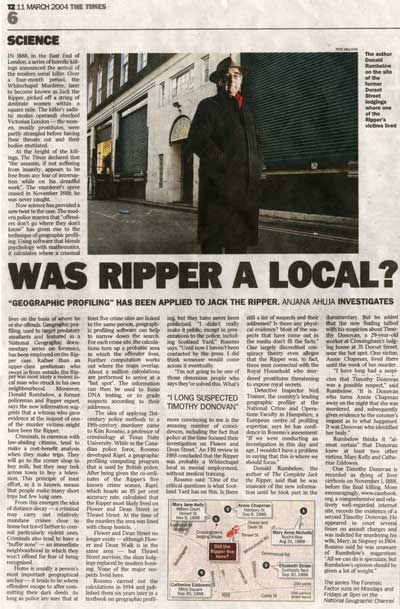
Hindsight is 20/20, but let's consider this. Instead of the "Special X" cops in that 1999 photo being snapped outside the wooden doors of the Tudor building...

(Photo by James Kennelly)
...let's move them inside, where an integrated Murder Squad has worked since 1981: the Olson shambles. It's there - under one roof - because the Mounties and the VPD are well-aware of George Santayana's famous warning: "Those who cannot learn from history are doomed to repeat it."
C/Supt. Robert DeClercq (in the corner office) is not a commander who suffers fools gladly. As Slade's agent once put it: "He may not be the guy we want to share a beer with, but we all sleep a whole lot better knowing he's on guard." Every cop worth the badge yearns to work Homicide. So every Mounted Police and VPD officer knows the edict from DeClercq's Strategy Wall: "ViCLAS reporting weighs heavily in deciding who joins Special X. Integrated Homicide is no place for deadwood detectives."
In 1997, Robert Pickton was charged with attempted murder. He picked up a prostitute in Vancouver's skid road with an offer of $100 for oral sex, and drove her to his trailer on the Port Coquitlam pig farm. A fight ensued when he tried to handcuff her. After Pickton stabbed the woman four times, she managed to flee to the highway. A motorist stopped, then drove her to the hospital. A key to the cuff around her wrist was found in Pickton's pocket. Because she was a drug addict, all charges were later dropped. The Crown thought her too unstable to testify.
For more than 7 years, the clothes and rubber boots seized from Pickton on the night of that attack sat in an RCMP storage locker. When they were finally tested in 2004, DNA from two of the Missing Women was recovered.
Furthermore, in 1998, VPD detectives received a tip about Pickton and "all the girls that are going missing." The tipster had seen different women's purses and identification at the pig farm. Nothing came of it because the VPD rejected Rossmo's warning.
Why - you might ask - was a British detective in the 1999 photo? Because while the VPD was trying to give its supercop the heave-ho, Britain's National Crime Faculty (the U.K. version of the FBI's Behavioral Science Unit) had sent a detective to be trained in Geographic Profiling. He then trained two officers from Scotland Yard.
Imagine what might have happened with better leadership. When Rossmo's formula surfaced the presence of a stealth killer in 1998, the VPD should have dispatched him (with all his past experience working skid road and the prostitution task force) to the Mounties' "Special X" (had it existed).
There, with all the Missing Women information under one roof, the integrated detectives would have gone after Pickton, who hunted victims in the realm of the VPD, and butchered them in the realm of the Coquitlam Mounties.
The cops in the 1999 photo had all read GHOUL, and Rossmo knew all about the Haarmann and Grossmann cases behind it.
"Pigs? Mystery meat? How do you get rid of 65 Missing Women without a trace? You don't suppose..."
"Let's check Pickton out."
When the pig farm was searched in 2002, the police found skulls cut in half and stuffed with hands and feet. Another victim was garbage-bagged at the bottom of a trash can. A woman's jawbone and teeth were found by the slaughterhouse. In the laundry room, a .22 pistol had a dildo on its barrel. Plus the DNA of Pickton and a victim.
Had there been a "Special X" in 1998, might those real-life cybercops have solved the Pig Farm Case, as they do other murders in PRIMAL SCREAM, BURNT BONES, and DEATH'S DOOR? If so, 13 women might still be alive.
You decide.
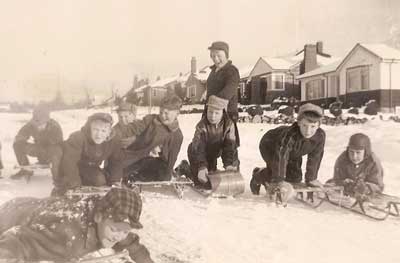
"Rosebud" (1956)
If you live in a snowy climate, you might have a photo like this. It could be the opening of IT'S A WONDERFUL LIFE (1946) or CITIZEN KANE (1941).
Slade is second from the left, behind the checkered hat. His best friend, laughing, is patting his back. It makes you wonder what these boys will grow up to be. Slade's best friend became a top-notch trauma and cancer surgeon. In his 30s, he was struck down by brain cancer. Slade gave the eulogy at his funeral.
A jolt like that makes you rethink life. Slade's a city boy, born and raised. Just as Citizen Kane died with "Rosebud" on his lips, Slade didn't want to die murmuring, "I should have lived in the country." So, for a good chunk of the ensuing years, he kicked back in the bucolic Gulf Islands (Canada) and San Juan Islands (the United States).
One day, he was lounging on the beach when a wicked thought came to him. "What a good way that would be to dump the mutilated bodies of serial victims and taunt the Mounted Police. Come in by boat under cover of night and leave them on the beaches."
Eventually, that became the plot of DEATH'S DOOR.
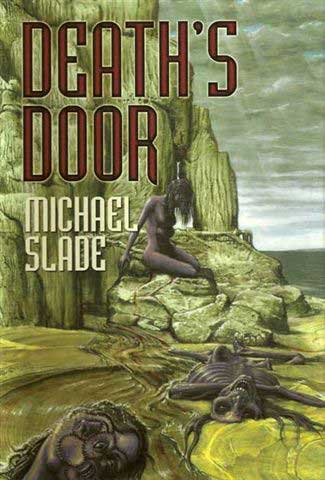
This cover image by Alan Clark condenses the thriller's mutilated remains dumped on different Fraser River and West Coast Islands beaches. The mutilations were done by a spurned, vengeful, psychotic plastic surgeon. Breast enhancements, face lifts, and liposuction.
On August 20, 2007 - 6 years after DEATH'S DOOR was published - a man's severed right foot in a running shoe was discovered on the shore of Jedediah Island. Six days later, another man's severed right foot in a running shoe was found on the shore of Gabriola Island. Three more severed feet, all wearing shoes, followed in 2008: February 8, a man's right foot on Valdez Island; May 22, a woman's right foot on Kirkland Island (in the Fraser River delta); and June 16, a man's left foot (a match to the February 8 foot), on Westham Island (in the Fraser River delta).
After the 5th foot was found, a Vancouver radio station linked the weird beach discoveries to the plot in DEATH'S DOOR and interviewed Slade in June 2008. The Mounted Police had rejected foul play because there were no tool marks on any of the feet. Therefore, the feet had separated naturally.
Not necessarily, Slade replied as devil's advocate. If the victims were weighted down nefariously, the feet would still separate in the same way. He was puzzled by three questions: Why are only feet being found? Why are they all clad in runners? And why are they being found in the same area?
Nowhere else in the world had multiple feet surfaced. Slade had lived on the West Coast since 1955, and no severed feet came ashore in the 1950s, 60s, 70s, 80s, 90s, or up until 2007.
Nor did no tool marks = no foul play. In Stephen King's novel MISERY, an obsessed fan hobbles a captive writer by chopping off his foot with an ax. So, tool marks. But in the movie version, she puts a block of wood between his ankles and slams his foot from the side with a slegehammer. The foot severs "naturally."
On leaving the studio, Slade was handed interview requests from all three TV networks. His comments went national, the story made CNN, and NEWSWEEK wrote on June 24, 2008: "Criminal attorney and Vancouver author Michael Slade has said publicly that he thinks a serial killer may be on the loose. That theory is gaining traction..."
Since then, 7 more severed feet have washed ashore. In 2008: August 1, a man's right foot, shoed, near Port Angeles, Washington State; November 11, a female left foot, shoed (matching the May 22 foot), on a Fraser River beach near Richmond. In 2009: a man's right foot, shoed, on another Fraser River beach near Richmond. In 2010: August 27, a female right foot, shoeless, on Whidbey Island, Washington State; December 5, a boy's right foot, shoed, on the beach of Tacoma, Washington State. In 2011: August 30, a foot, gender unknown, shoed, in Vancouver, British Columbia; November 4, a man's right foot, shoed, in Sasamat Lake, British Columbia.
The Mounted Police still reject foul play. In August 2010, a national TV network asked a forensic anthropologist for her opinion on whether Slade's MISERY sledgehammer scenario could produce a "naturally" disarticulated foot? That's possible, she stated.
Given the probability odds against 12 severed feet surfacing in that small an area in that short a time, Kim Rossmo's comment was, "This is really, really weird!"
So, what's going on?
You decide.

KAMIKAZE (2006): Here, Slade's "foresight" was in the research, not the aftermath of publication.
How do you decide to use a secret weapon like that without warning to fry 140,000 mostly-civilians alive? That was the question that Slade reseached for a year in pre-Law, using only primary sources recorded by those involved in the decision. His conclusions are in this essay written in 1968:
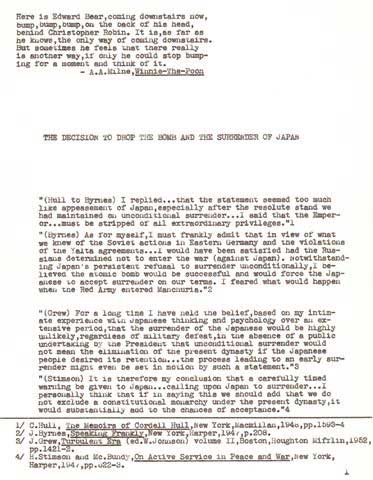
Slade's essay THE DECISION TO DROP THE BOMB AND THE SURRENDER OF JAPAN
Eleven years later, in 1979, President Truman's secret Potsdam diary came to light. Four years after that, so did telling 1945 letters to his wife Bess. Taken together, they confirmed Slade's conspiracy theory. That confirmation underpins KAMIKAZE's plot, in which a vicious Japanese Yakuza gangster boss comes looking for revenge against those who fried his family.
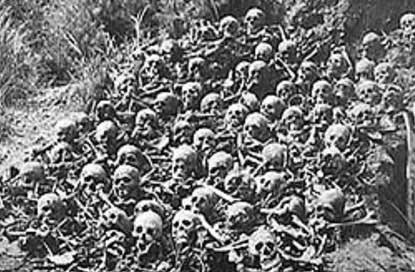
Hiroshima civilians, after the bombing

CRUCIFIED (2008): Slade thoroughly enjoyed William Peter Blatty's novel THE EXORCIST (1971), and the movie made from it (1973).

THE EXORCIST
If Slade were Satan, however, he wouldn't possess a 12-year-old girl. He'd take over one of his sworn enemies: a Roman Catholic priest.
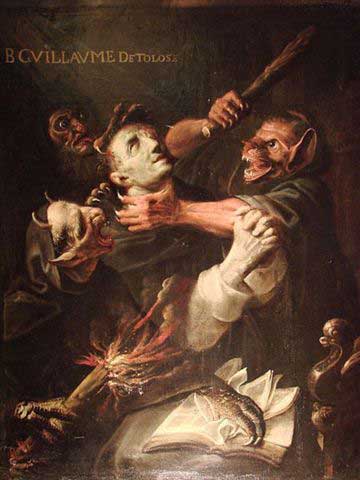
(Photo by Guerin Nicolas, licensed copyright)
St. Peter's Basilica at the Vatican is built on the footprint of the Circus of Nero:
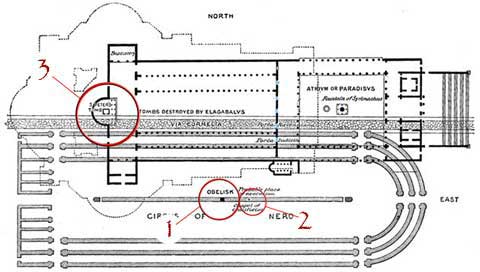
The Circus of Nero - a pagan arena worthy of Satan himself - was soaked in sacrificial blood. Beside the Egyptian obelisk (1) on its central spine, St. Peter - a disciple of Jesus and the first pope of the Roman Catholic Church - was crucified upside down (2). St. Peter's Tomb is under the altar in the Vatican's Basilica (3).
In these accurate depictions of the Circus by Jean-Leon Gerome (1824 - 1904), note the crucified wretches burned as torches to light the overlapping pagan and Christian rituals.

THE CHRISTIAN MARTYRS' LAST PRAYER (1883)
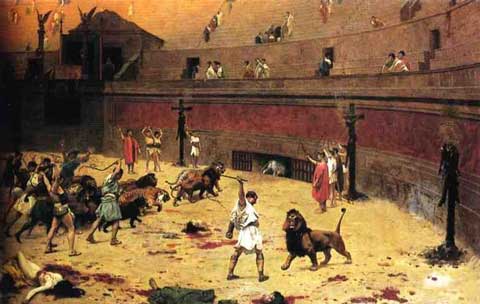
DEPARTURE OF THE CATS FROM THE CIRCUS (1902)
Until he became Pope Benedict XVI in 2005, Cardinal Joseph Ratzinger led the Congregation for the Doctrine of the Faith (successor to the Inquisition) from 1982 on. With the world's largest library of satanism, witchcraft, and sorcery, the Palace of the Holy Office - Congregation headquarters - literally sits on top of the Circus of Nero:
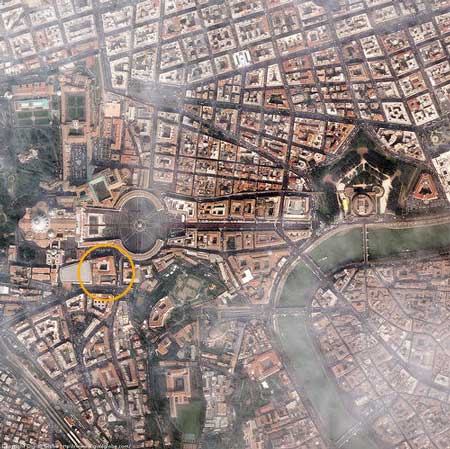
Home of the Inquisition (circled)
(Digital Globe, licensed copyright)
If you've read the same books Slade has, and seen the same movies, you know the perils of building something on top of a pagan graveyard.
Can you imagine a troubled young priest sitting in a secret room at the Palace of the Holy Office, on top of that pagan field of blood and its adjoining graveyard, surrounded by Inquisition records containing blasphemous incantations said to conjure Satan and open the gates of hell?
Question: Which branch of the Catholic Church would Satan most likely possess?
In 2004, the Beasts of Satan shocked Italy. The heavy metal rock band masked a cult of devil worshipers. In 1998, the Beasts of Satan sacrificed two teens to the Evil One in a full moon blood ritual in the woods north of Milan. Six years later, their leader killed a cultist who threatened to snitch. "Blood and death, blood raining down, blood bathing all my body, blood thirsty for blood," he recorded in his book of incantations. "Pitiless, we will eliminate and cleanse, donating the ash of our enemies to he who sits on the throne."
Eight Beasts of Satan were jailed.
A conservative theologian, Pope Benedict XVI holds strong views on the Devil and exorcism. The Vatican reacted to the Beasts of Satan by training hundreds of new exorcists at its university - the Athenaeum Pontificium Regina Apostolorum - run by the zealous Legionaries of Christ. "Thanks be to God," said the Chief Exorcist, "that we have a Pope who has decided to fight the Devil head-on."
Who thwarts Satan more than an exorcist? So CRUCIFIED's possessed priest is a Legionary of Christ.
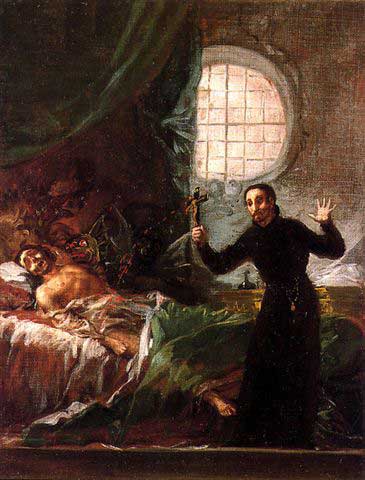
PERFORMING AN EXORCISM by Goya (1788)
The Legionaries of Christ enjoyed favor at the Vatican under Pope John Paul II, who admired their conservatism and success in recruiting new priests at a time when the overall number was declining.
In 2010, Pope Benedict XVI decreed that the Legionaries of Christ required "profound revision" to "purify" them. For decades, their founder (who died in 2008) had lived the double life of a Jekyll and Hyde. His "extremely grave and objectively immoral behavior" leading to "real crimes" showed "a life devoid of any scruples and any authentic sense of religion." He had created a cult-like "system of power" built on obedience and deceit that allowed him to sexually abuse young boys unchecked, and to father at least three children.
"Purify" included the Legion's lay wing, Regnum Christi, with 70,000 Catholics in more than 30 countries. In Regnum Christi, the Legionaries dominated 900 "consecrated women" whose lives were dictated in every detail, from how to eat a piece of bread to the 6 movies they could watch a year. Silence was their norm, emails were screened, friendships discouraged, and families kept at bay.
Unlike nuns, who make their vows to God, "consecrated women" vowed to the Legionaries. They were required to "renounce the use of their capacity for decision-making." As one Jesuit put it, "No one can give away that basic component of humanity" and not "become a zombie."
Sins of such magnitude "threatened to its roots the congregation itself." So, in a crackdown on the ungodly cult, the pope ordered a special envoy to cleanse the Legion from top to bottom.
Slade is an agnostic, so when it comes to exorcizing demons, he'll take it from true believers.
As in CRUCIFIED, are the Vatican's exorcists being exorcized?

RED SNOW (2010): The threat of terrorism hangs like the Sword of Damocles over all major sporting events.
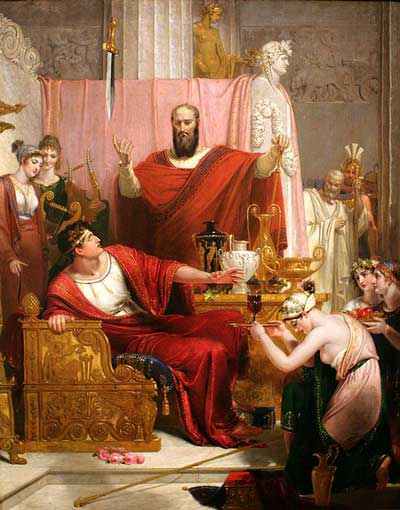
SWORD OF DAMOCLES by Richard Westall (1812)

Nothing offers a better terrorist target than the Olympics. The Munich Games suffered an attack in 1972: the massacre of 11 Israeli athletes and coaches and 1 West German police officer.
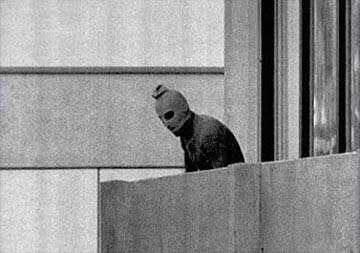
A masked Black September terrorist at the Munich Olympics
RED SNOW takes place at the 2010 Winter Olympics, but its real-life connection won't fade with time. Yes, Whistler Mountain dodged the terrorist bullet, but its pre-Games anxiety and suspense will return every four years with upcoming Winter Games.
To see if RED SNOW has "foresight," we must wait for the future.

So back to the opening question and the laws of probability. "Slade seems to have a lucky knack for glimpsing what's to come. Consider the improbable odds of foreseeing all of this." In other words, does Slade have a crystal ball?
Hardly.
In fact - given how he plots - the laws of probability predict that Slade will be right a foreseeable number of times. The flip side of "Those who cannot learn from history are doomed to repeat it" is "Those who study the past can see the groundwork of the future."
Every Slade novel emerges from his boyhood interests. By reading every book he can find on a historical subject (see the Bibliography at the end of each novel), the plot finds Slade. Then it's a question of filtering the past through the present to extrapolate into the future.
Slade's theorem: "The future is in the rearview mirror."
"How I Spent My Summer Vacation"
A Memoir by Michael Slade
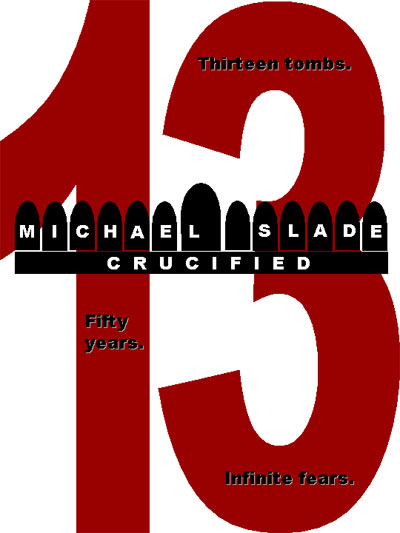
CRUCIFIED - my 13th novel - is now published. It introduces Wyatt Rook, a new character. After 12 thrillers about Special X, the psycho-hunters of the Royal Canadian Mounted Police, why did I switch to writing about a New York lawyer? Here's the story.
My father died in a plane crash in 1956. I was 9 years old. After surviving 47 combat missions as a bomber pilot in the Second World War, he was killed by a raging winter storm in the Cascade Mountains. To this day, the Mount Slesse crash remains the worst aviation disaster in Western Canada.
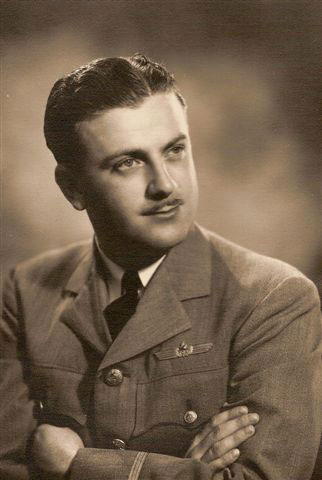
Most memories of my dad are hazy, but not this one. I was building a plastic model plane - the type boys used to hang from the ceilings of their bedrooms - when my dad pointed to a half-made plane that I had abandoned for the niftier Stuka.
"Never start a project that you don't intend to finish," he admonished me. "If you're not going to complete something, don't start work on it. You began work on that plane, so you've made a promise to yourself that you'll finish it."
Then he was gone.

Because my father died while flying for the airline, I had a free pass for as long as I was in school. My mother set about introducing me to the big, wide world. First stop, of course, was this brand-new fantasy in California called Disneyland. Next, we were off to New York City: "There are 8 million stories in the Naked City." For a kid from the sticks of 1950s Vancouver, imagine the size of that place.
Flying on a pass means you fly standby. You take the seats that are left. So my mom and I got separated on the leg from Toronto to New York. The man sitting beside me was a high-powered stockbroker type, who found himself peppered with questions about Manhattan by the excited boy next to him.
"Do you know famous people?" I asked.
"Sure," he said. "Right now, I'm off to meet Jack Dempsey."
"Jack Dempsey! The Heavyweight Champ of the World!"
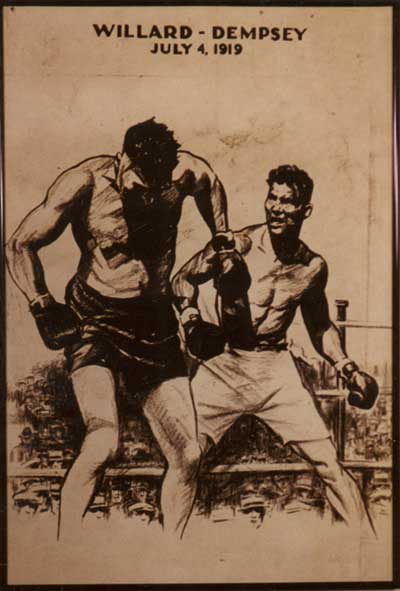

Known as the "Manassa Mauler," Jack Dempsey scored 51 knockouts in 82 fights, and held the title from 1919 to 1926. The street where Madison Square Garden is located is called Jack Dempsey Corner.
The landing of the plane reunited me and my mom. She was a knockout, in her own way.
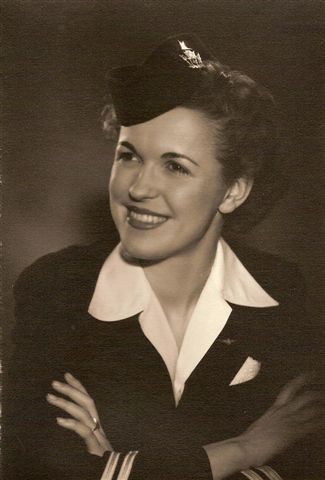
The stockbroker took one look at her and offered us a cab ride into the city. Thanks to her son, my poor mom found herself hit upon by a high-pressure guy on the make who was going to show her the city. And - to impress her through me - he had the taxi pull up in front of Dempsey's Restaurant, "The Meeting Place of the World," opposite Madison Square Garden.

The stockbroker told the cabbie to wait while he went inside, and a minute later, out he came with Jack Dempsey.
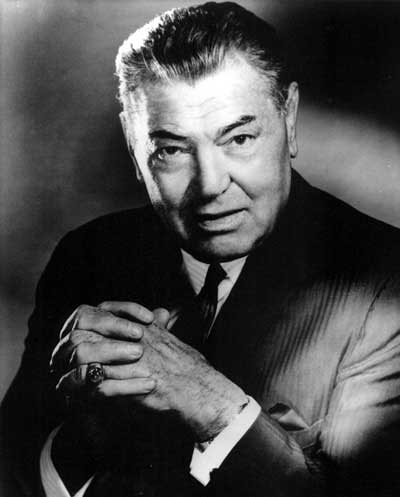
Soon, we're all standing on the sidewalk, with the stockbroker telling my mom that he'll find someone to watch the kid so they can "paint the town red," and that's when my mom took a stand.
She explained to him, in Dempsey's company, how she had lost the boy's father to a plane crash, and was here to show me the city, because that's what her husband would have done. She was thankful to my seat-mate for being so kind to us, but we had flown a long way (prop planes back then), and she had mapped out every minute that we would be in the city.
Dempsey turned to the stockbroker and told him to go inside and order a drink on the house. Once he was gone, the towering man looked down at me and said, "So you know who I am?"
"You're Jack Dempsey! The Heavyweight Champ of the World!"
Dempsey squatted down on his heels and said to me, "Yes, I'm a fighter, and you know what that means? It takes a fighter to know a fighter, and your mom's a fighter, son. So you be a fighter, too, and take good care of her."
That's when he gave me a soft punch on the shoulder like men did back then (and I have not washed that shoulder since, for you're reading a story by one of the few to take a punch from Jack Dempsey and still be on his feet).
Dempsey got up and held the cab door open for my mom. Then, leaning in through the passenger's window, he peeled off several bills from a wad in his pocket, and told the cabbie, "Give my guests a grand tour of the city, and see they get safely to their hotel."
"Yes, sir, Mr. Dempsey," the cabbie replied.
So that's how my mom and I were introduced to the Big Apple, courtesy of the Manassa Mauler.
Visualize me with my head stuck out the window of the cab, gazing in awe at the Empire State Building soaring up to the moon, blinking at the zillions of lights on Broadway and in Times Square, and riding on Fifth Avenue with all its top hats and mink stoles.
The thought going round and round in my mind? "Wow! So this is the home of Ellery Queen?"

CREATIVE WRITING SUMMER SCHOOL COURSE.
Voluntary, No Credit.
Admission Restricted to Grades 9 to 12.
The notice went up on the bulletin board of my high school in June. I was in Grade 7. On my way home, I stopped at the confectionary and bought Ellery Queen's CAT OF MANY TAILS.
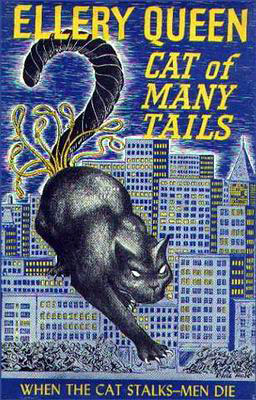
There was a time when a critic could say, "Ellery Queen is THE American detective story." Queen was both the fictional character and the pen name of two cousins from New York: Frederic Dannay and Manfred B. Lee. Queen wrote brain twisters from 1929 on, and - along with the Golden Age puzzlers Agatha Christie and John Dickson Carr - impressed me in my teens. Queen's stories were tricky whodunits with a "Challenge to the Reader: You have all the facts now to come up with the only logical solution." Launched in 1941, ELLERY QUEEN'S MYSTERY MAGAZINE is still going strong today.
My mom picked up on my glum face, and asked me what was wrong. I told her how much I yearned to take the Creative Writing course, but couldn't get in because I was only Grade 7. So she went to the school to argue my case. The teacher of the course said he'd make an exception, if I could be trusted not to be a class disrupter. Since Grade 9s and 10s had no intention of giving up their summer holidays for more school, I found myself the lone Grade 7 among a class made of Grade 12s and 11s.
That was a magic summer. First, the weather was perfect. Every morning was filled with sun. Have you ever been part of a group where you were the runt of the litter? I had all these big brothers surrounding me on a journey to imagination.
For weeks, we learned the basics of plot, character, dialogue, setting, and theme. Because that was the 1950s, theme carried a heavy dose of moral epiphany: that moment when your hero has a sudden, deep insight into "the right thing to do."
The goal of the course was for each of us to write a short story. On the morning of the final day, we were to stand up in front of the class and read our creations. My story - "The Restless Corpse" - introduced my detective, Daryl Tombe, who was heavily influenced by Ellery Queen. Come that final morning, it was another sunny day. As soon as the bell rang, we'd be out of there, off to catch the end of the summer that each of us had voluntarily given up. And come the bell, the janitors would quickly shut down the school, so they could be off for their summer holiday.
The class began with the Grade 12s reading their stories, and they were good! Then came the Grade 11s, and they were good, too! My hands were so sweaty from anticipation that the sheets of paper they held were warping by the minute. Finally, the teacher said, "Last but not least, we have a thrilling mystery by Jay Clarke."
And that's when - RIIIIING! - the bell sounded.
Up jumped all my classmates, congratulating each other. They began to clean out their desks to be off to a party they'd planned at Jericho Beach, leaving me sitting in my seat, with my story unread. As the room cleared out, the teacher approached me and said, "I'm sorry, Jay. Life isn't fair."
Grade 7 was the year we studied Classical History, so he asked, "Where did Socrates teach Plato?"
"Under a tree," I replied.
"Go clean out your locker and meet me at the big tree beside the soccer field. You can read your story to me."
Big deal. He'd already read it. [My report card would later say: "His interest at the moment leans toward producing fiction with a homicidal flavor, but it will expand toward other themes." Ha!].
As I walked along the dim hall to my locker (the janitors had shut down the lights), I could see the rest of the class piling into cars out front of the school. The 1950s were the hot rod years, and one teen had this beautiful roadster, all candy apple red. Another car was one of those big-boat V-8 convertibles that got two miles to the gallon, because there was enough gas in Texas to last more than 1,000 years. Then off they went in a procession, heading for Jericho Beach.
The only open door was out the front of the school. I recall kicking a pebble around the side of the building. Out back, there was the teacher sitting on the grass under the big leafy tree. I suspect my shoulders were slumped as I shuffled across the field, and probably swore to myself that I would never write another word of fiction. I was in a funk.
Then off in the distance and roaring in fast, I heard the werewolf growl of a souped-up car. Soon, it shot into sight on the far edge of the field, the dazzling red hot rod followed by the rocking convertible and the other cars. One by one, they pulled up at the curb and the passengers scrambled out. By the time I reached the tree, the class had joined the teacher.
"I thought you were going to the beach?" I said.
"We were," someone replied...
What happened was they were driving down 4th Avenue when an arm came out of the hot rod, motioning up and down to pull the cars off to the side. One of the Grade 12s said, "This isn't fair. We left the kid unread. I have to go back. Will someone give me a ride? Years from now, I don't want to be writing a tale of guilt over this." Then someone else said, "You're going back so you'll be the hero of this story, and I'll be the jerk who left the Grade 7 behind. I'm going back, too." And by the time it was over, they had all decided to go back.
"What about the beach party?" I asked.
"There'll be other days for parties," the Grade 12 said, "but it's not every day you get to hear a thrilling mystery by Jay Clarke. You've got the grass, Hemingway. Let's hear it."

I was so pumped that I rushed home and retyped the story onto sheets of folded 8 1/2 x 11 paper to create a book's signature, which I stitched down the spine with my mom's sewing kit. Here - from the summer of Grade 7 - are the first words written by "Michael Slade."

I wrote three more stories - "The Telltale Timepiece," "King of the Castle," and "The Iron Room" - until I had 100 pages for 13 TOMBES, Volume One. There were to be 13 mysteries - "tombs" - about Daryl Tombe. [In hindsight, I wish I'd named him Daryl Tomb, no "e." But I had just turned 13, and you can't rewrite history.] Were there illustrations? Of course. No expense was spared on this publication. Here's a scene from "King of the Castle."
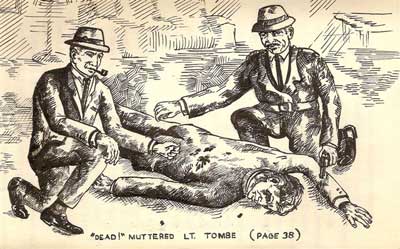
And a scene from "The Iron Room."
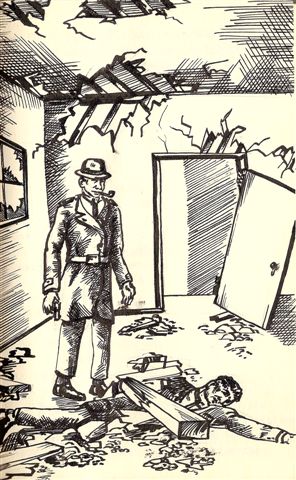
Were there maps to help the reader with the whodunit puzzles? What Golden Age mystery writer didn't use them?
Finished, I tied the signatures together and cut a thin strip from a Rice Krispies box to rubber cement along the stitched edge to create a spine. Now I had the guts of a book. To make it look like a real book, I wrapped the pages in a dust jacket.

Every Saturday, after the movies, I haunted Duthie Books. The legendary local booksellers Bill Duthie and Binky Marks were my literary gods. The week I finished Volume One, I waited till Bill was free, then I slapped 13 TOMBES down on the counter and said, "Mr. Duthie, I've written a book." He called Binky Marks up from the Paperback Cellar to see my work, and they asked if I'd leave it with them for a week to read.
The following Saturday, I returned, heart in my throat, to get my first review. In the interim, they'd taken my pages to a bookbinder and had them put into hardcover with the title and my name in gilt on the spine. I was stunned. Bill handed it to me and said, "It's in a limited edition of one copy, but here's your first published book. Promise me that one day your novels will be for sale in my store."
I promised.
And they were.

Volumes Two and Three of 13 TOMBES were never written. I discovered girls, parties, and such. That's the only project I never completed, and I suffered the guilt of knowing I broke that promise to my dad.
Well, here it is. My 13th novel; my 13th mystery; my 13th tomb.

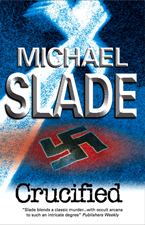
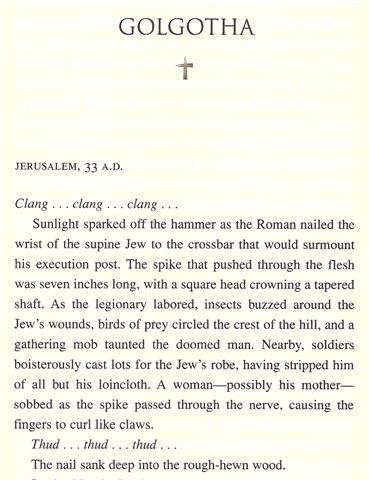
Is CRUCIFIED illustrated, and does it have a map to help readers solve the puzzles? Of course. Here's biblical Jerusalem's Temple Mount, Golgotha, the Tomb of Jesus, and Haceldama.
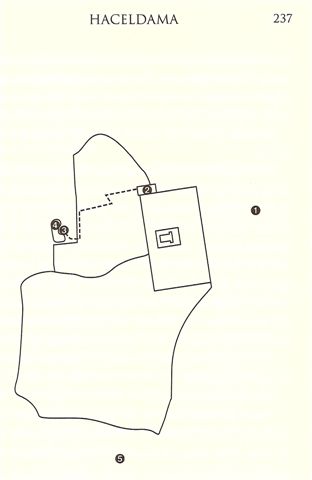
And how better to make the full-circle connection back to 13 TOMBES than to bring back Daryl Tombe, in spirit. As a Canadian author, you're not supposed to "sell out." But since I've written 12 novels about the RCMP, I figure I've earned the right to create a New York lawyer. Daryl Tombe was inspired by Ellery Queen. So what should I call my detective?
Naming is fun. Sherrinford Holmes became Sherlock Holmes. Zantar got switched around to become Tarzan. Dallas McGee became Travis McGee after JFK was shot. Inspectors Morse and Rebus both suggest decoding.
If I'm going to do an American, I want an American name. Wyatt from Wyatt Earp will fill the bill. How do I make the link back to Ellery Queen inspiring Daryl Tombe? The queen is the most powerful piece on a chessboard. The next most powerful is the rook.
Meet Wyatt Rook, lawyer, historian, detective...
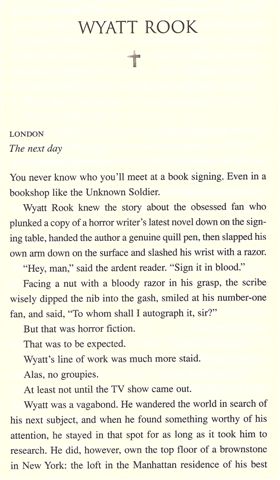
I don't know if there's an afterlife. But if there is, I'll be able to look my father in the eye. "It took me half a century, but I wrote 13 tombs. No project went unfinished, Dad. I kept my promise for you."



